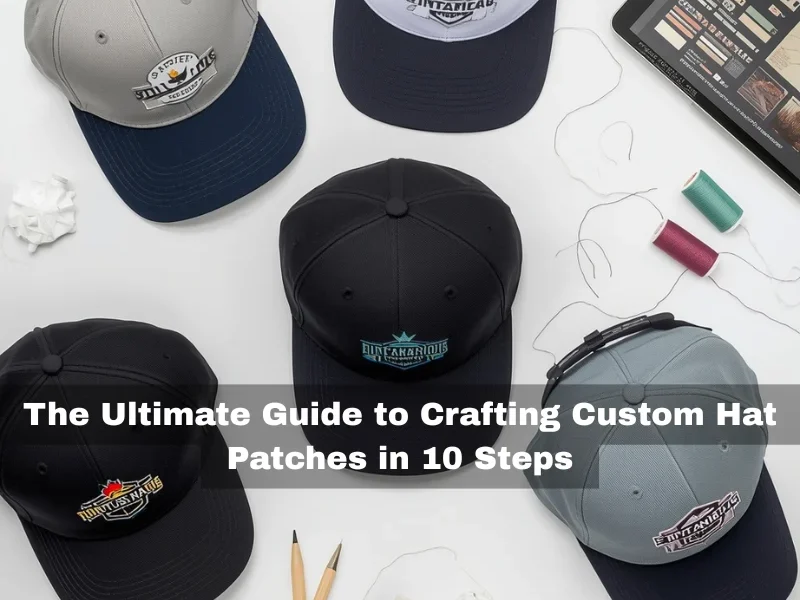Your hat narrates a story, and the custom patch is the language they speak.
Whether it is a baseball cap, a trucker hat, or a trendy snapback, a patch can transform a plain accessory into a unique statement. From representing a sports team to promoting a business or showcasing personal style, custom hats with patches have become a modern trend that seamlessly blends fashion with creativity.
But a perfect patch is not just about the right stitch; it is about following the proper steps. Let’s take this blog on a ride into the process from concepts to creation, and discover how your hat patch can become unforgettable.
Turn Your Ideas into Wearable Art
Before we proceed to the technical steps, let’s understand that designing custom patches is not just about fabric and thread. It is a journey where your vision can transform into something people would love to see, touch, and proudly wear. These steps will guide you from a spark of inspiration to a finished patch that fits perfectly on any hat.
Step#1: Define the Purpose of the Design
Every patch starts with an intention. Question yourself if it is for branding, personal styling, a sports team, or a fashion line? Having a clear purpose ensures your design carries meaning.
- Define the story or the message behind each patch thread.
- Choose either a causal, professional, or creative theme.
- Decide whether it will be for limited edition hats or for bulk production.
Step#2: Sketch the Initial Design
A patch begins with a sketch. This does not need to be perfect art; it is about bringing your ideas onto paper before moving to digital tools.
- Draw rough shapes, symbols, or text.
- You can experiment with styles like modern, vintage, or minimalistic.
- Highlight the focal point that can grab attention.
Step#3: Select the Right Shape and Size
The shape and size you choose for your patch have a significant impact on its visibility and overall appearance. A circular or shield-shaped patch gives a traditional vibe, while the custom outlines make it look unique.
- Some of the common shapes include round, oval, square, and shield.
- Small patches create a subtle style while the larger ones make a bold statement.
- You must measure the dimensions of your hat to avoid disproportionate designs.
When taking the shapes, circles are often used in sports and casual hats. The shields are used for designing patches for clubs and uniforms. Rectangular shapes are used for logos or text-heavy art. Custom cuts are best suited for trendy or unique styles.
Step#4: Choose the Right Fabric
The fabric is essential as the base of your patch and determines its durability. The strong material ensures that the patch has a long-lasting effect, even with frequent use of the hat.
- Twill is durable and easy for embroidered designs.
- The felt offers a soft and vintage look.
- The denim and canvas give a rugged vibe.
- The lightweight polyester is best for detailed designs.
Step#5: Pick a Color That Can Pop
The color palette you choose influences how people will see your custom hat patches. The right mix will make your design eye-catching, while the poor choice will make it fade into the background.
- Go for contrasting shades so you can highlight the details.
- Stick to choosing a maximum of 4-6 colors for more clarity.
- Choose thread colors that can match or contrast with the hat fabric.
Step#6: Decide On the Patch Style
The patch style will define your design coming to life. Each type has its unique charm and effect on the final look.
- The embroidered patches will give a textured, classic, and bold look.
- The woven ones look smooth and are great for intricate details.
- The chenille emblems are soft, fluffy, and give a vintage-inspired look.
- Printed ones use vibrant colors to bring a photorealistic look to the design.
Step#7: Add Borders for a Defined Look
Boarders are not just for decoration. They enhance the look of the patch by giving an outline and preventing it from fraying. Choosing the right edge style will give your patch a polished look.
- The Merrowed edge is thick and rounded, giving a classic patch look.
- The heat-cut edges are sharp and precise for complex shapes.
- The raw edge with backing is minimalist. They are best for fashion-forward designs.
Step#8: Pick the Backing Type
The backing you choose for your designed patch will determine how you attach it to the hat. Each option has its own pros and cons, but you will decide depending on your preferences and usage.
- The iron-on backing is quick and straightforward to attach. This is one of the reasons they are loved for their DIY projects.
- The Velcro backing is easy to remove with high versatility.
- For a strong and permanent touch, you can use sew-on backing.
- Unlike the strong, there is an option for temporary and lightweight backings. You can choose adhesive.
| Backing Type | Durability | Ease of Use | Best For |
| Iron-on | Medium | High | DIY, casual hats |
| Velcro | High | Medium | Tactical or work hats |
| Sew-on | Very High | Low | Long-term use |
| Adhesive | Low | Very High | Short events, promos |
Step#9: Time to Place Your Patch
Placement is as important as the design process. The location you choose for the patch will either enhance or detract from the look of your hat.
- Placing it on the front center for classic and maximum visibility.
- Choose a side panel for a stylish and modern look.
- The back of the hat can be used for a subtle branding choice.
- For unique, hidden details, the area under the brim is best suited for creative designs.
Step#10: Work With a Trusted Manufacturer
Even if your design is the best, it can fall without the proper execution. A reliable manufacturer ensures that your patches look professional and last a long time.
- Look for the suppliers with positive reviews.
- You must ask them for the sample patches before you place your bulk order.
- Compare all the pricing without compromising on the quality.
The Final Comment
Custom hat motifs are more than just accessories; they’re tiny canvases that tell big stories. From shaping your concept to selecting the proper backing and style, every decision contributes to the character of your final creation.
Whether you are building a brand, designing for a team, or creating something personal, these ten steps provide a roadmap to success. With creativity and the proper process, your patch won’t just decorate a hat; it will define it. So, put your imagination to work, and let your custom patch speak louder than words.

